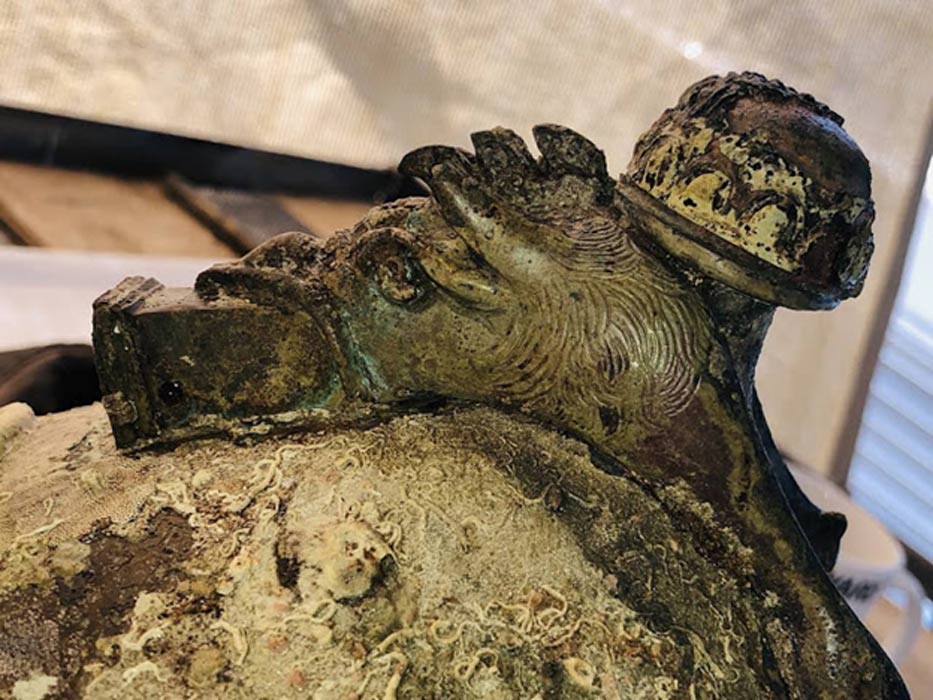Fascinating Artifacts from the Battle of the Egadi Islands are Pulled from the Depths
Underwater archaeologists have recovered a treasure trove of artifacts off the coast of Sicily from the site of the first ancient naval battle ever discovered , including warship rams, helmets, armor, and weapons dating back 2,000 years.
What was the Battle of the Egadi Islands?
The artifacts are the remnants of the Battle of the Egadi Islands (Battle of the Aegates) - the last clash from the first Punic War which took place in 241 BC. The Romans fought the Carthaginians in a battle that culminated from more than 20 years of warring as the Romans struggled to gain a foothold in the Mediterranean sea.
While the Carthaginians were much more powerful on the water, the Romans lay in wait trapping the Carthaginians and blocking off their sea route in a sudden attack. Up to 50 Carthaginian ships were sunk, killing up to 10,000 men. The Roman victory set them on the road for Europe-wide domination.
- Devastating Defeat for Chinese Warlord in Largest Naval Battle in History
- Researchers locate Submerged Lost Ancient City where Athens and Sparta Fought a Battle
- What Went Wrong? The Real Story of the Battle of Thermopylae

‘Capture of the Carthaginian Fleet by the Romans.’ (Mary Harrsch/CC BY NC SA 2.0) The illustration depicts a Carthaginian galley flanked by two Roman galleys.
The Search Begins
The priceless hoard of artifacts had lain undisturbed on the seabed at a depth of 100 meters (328.08 ft.) for more than two millennia. In 2013, British archaeologists began the process of retrieving all the remnants which had been scattered over some five kilometers (3.11 miles).
More recently, the RPM Nautical Foundation, the Superintendence of the Sea of the Sicilian Region, and Global Underwater Explorers have joined in on the search. They have been using cutting edge technology aboard a ship to survey the entire nautical battlefield in detail, with the expectation that many more relics will be uncovered. This year they searched the depths while based on the oceanographic ship, Hercules.

A Roman helmet from the Battle of the Egadi Islands. (RPM Nautical Foundation)
Jon Henderson, an underwater archaeologist at the University of Nottingham, explained the significance of the work:
“There has never been an ancient whole battle site discovered before, which is quite surprising when you consider how important sea power is in the Mediterranean. The historical significance is huge, but what is so important is that we are finding battle sites because of changes in underwater technology. We are at the cusp of an exciting range of new discoveries.”

Raising a naval ram from the sea. (RPM Nautical Foundation)
Recent Discoveries of Impressive Artifacts
In the last three weeks of exploration, researchers have pulled many artifacts from the depths. They’ve found warship rams, 68 Greco-Roman amphorae, four Punic amphorae, and four plates.
- Mauritius: From Conquests to Naval Battles, Piracy and a Long-Awaited Independence
- New Finds at the Well-Preserved Wreck of the Formidable Warship Mars
- The Battle of the Delta: Ramses III saves Egypt from the People of the Sea
They also discovered three bronze Montefortino style helmets (a Celtic and later Roman style of headgear). Two of the helmets are amazingly well-preserved and have decorative animals on top – which Archaeology News Network says were defining features showing they “certainly belonged to the Roman army.” Altogether, there have been 25 helmets found on the seabed since excavations began.
But the most unique find is arguably the iron sword, which was found just last week. It measures 70 cm (27.56 inches) long and is five cm (1.97 inches) wide.

The iron sword. (RPM Nautical Foundation)
The artifacts will be analyzed and restored then added to the exhibition at the Museum of the "Battle of the Egadi" in Favignana.
Top Image: Detail of an animal on the top of a Roman helmet from the Battle of the Egadi Islands. Source: RPM Nautical Foundation
By John Black



















